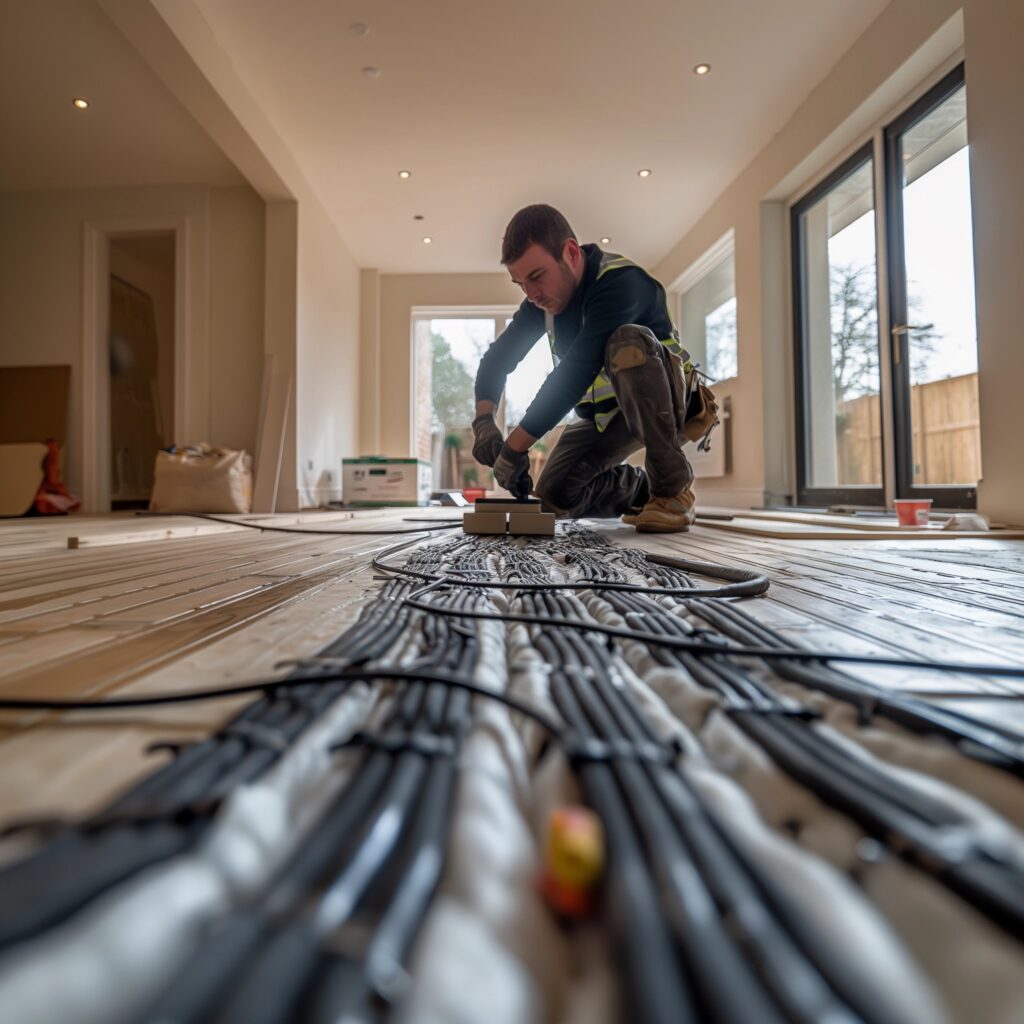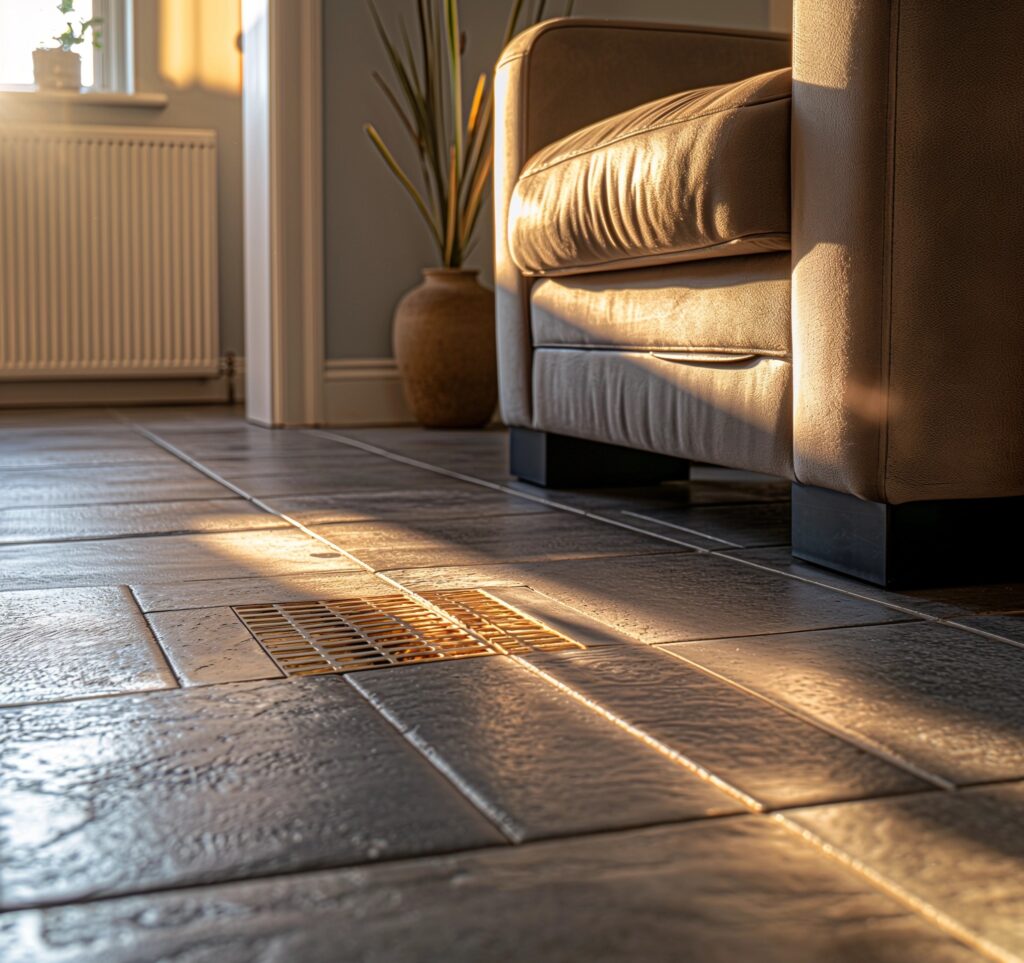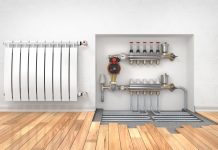Understanding Underfloor Heating Systems
Choosing between electric and water underfloor heating systems is crucial when considering how best to heat your home. Both options have advantages and challenges, and the right choice depends heavily on your specific home heating needs, the scale of your project, and your long-term energy consumption goals.
Heating Methods and Mechanics

Electric Underfloor Heating employs either heating mats or loose cable systems. These systems, often called “dry” systems, use electrical resistance to generate heat directly beneath your floor surface. The heat is then transferred from the mat or cables to the floor material, which radiates it into the room. This method provides a quick and efficient way to heat up a space, making it particularly suitable for smaller areas or rooms that require occasional heating.
On the other hand, Water Underfloor Heating, or “wet” systems, involves the installation of a network of pipes under the floor through which heated water is circulated. This type of heating takes advantage of the thermal mass of the floors, which absorbs the heat from the water and then slowly releases it upwards into the room. Although this method takes longer to heat a space, the overall warmth is more evenly distributed and tends to last longer even after the heating source is turned off.
Project Suitability and Installation Dynamics
Electric systems shine in renovation projects or when retrofitting heating into existing buildings due to their simplicity of installation. They require minimal disruption to the existing floor structure, making them ideal for adding warmth to already-finished spaces. Their installation can often be completed within a day and is feasible as a DIY project, although professional installation is recommended for optimal energy efficiency and safety.
Conversely, water underfloor heating is typically integrated into the construction phase of new buildings or during major renovations. The installation involves embedding a network of pipes in a layer of screed or directly within the floor slab, which can increase the overall height of the floor. This complexity makes it less suited for retrofit projects and almost always requires professional installation, adding to the initial cost and project timeline.
Cost Factors and Operational Efficiency
From a cost perspective, electric underfloor heating systems generally have a higher initial outlay primarily due to the cost of the heating elements and the electricity required to operate them effectively. However, they have lower installation costs. Electric systems use more energy in terms of operation, leading to higher ongoing costs, especially in areas with high electricity prices.
Water systems, while potentially more expensive to install—owing to the materials and labour involved—can be more economical over time. They are particularly cost-effective in larger installations where the even distribution of heat and the system’s ability to retain warmth lead to lower operational costs. Moreover, these systems can be integrated with renewable energy sources like solar panels or biomass boilers, enhancing overall energy efficiency and sustainability.
Control, Adaptability, and Long-term Considerations

Electric heating systems offer rapid responsiveness to changes in thermostat settings, making them ideal for quickly adjusting room temperatures. This adaptability makes it suitable for heating individual rooms or zones within a home, depending on use and occupancy.
Water heating systems, while slower to respond to thermostat adjustments, provide a more consistent level of heat across the entire floor surface. This makes them suitable for whole-home heating solutions, where maintaining a steady ambient temperature is more desirable than quick heating.
In terms of sustainability and long-term benefits, electric systems, although improving in efficiency with technological advances, still typically have a shorter lifespan and higher lifetime costs than water systems. Water underfloor heating is often viewed as a more sustainable investment. It is more durable and tends to increase property value more significantly, offering better long-term returns on investment.
Maintenance and System Health
When it comes to maintaining underfloor heating systems, both electric and water variants have specific needs that must be considered to ensure their longevity and efficient operation.
Electric underfloor heating systems are generally low-maintenance. Once installed, there isn’t much that needs to be done regularly apart from ensuring that the thermostat and other controls function correctly. However, it is crucial to have a professional check the system before it goes into operation and occasionally after that to ensure that all components, including the mats or cables, are intact and free from damage. Any breach in the heating elements can reduce the system’s efficiency and pose safety risks.
Water underfloor heating systems require more attention, primarily due to their complexity. Annual maintenance is advisable, which should include checking the boiler or heat source, the manifold, and the pipes for any signs of leaks or corrosion. Additionally, it is essential to ensure that the water circulating in the pipes is correctly treated with inhibitors to prevent sludge build-up, which can impede the system’s efficiency and increase wear and tear. Regular maintenance helps detect issues early, potentially saving on costly repairs or complete system failures.
“Both electric and water underfloor heating systems have unique requirements to guarantee long-term efficiency and functionality. Ensuring all components are defect-free and properly installed for electric systems is crucial. On the other hand, water systems demand regular checks for leaks and proper fluid treatment to prevent system degradation. Staying proactive with these steps is key to maximising the life and efficiency of your underfloor heating,” – Charles Mitten, Mittens Underfloor Heating London.
Decision Factors for Homeowners

Deciding between electric and water underfloor heating systems involves several considerations beyond a mere preference for one type. Homeowners should evaluate the following factors:
- Size of the Space: Electric systems may be more cost-effective for smaller areas or individual rooms, while water systems could be better for larger spaces due to their efficiency at scale.
- Existing Infrastructure: Installing water-based systems can be more invasive and may require significant structural changes, making electric systems a preferable choice for retrofitting.
- Budget Constraints: If upfront cost is a significant concern, electric might be the way to go due to its lower installation price. However, water systems appeal to those who can invest more initially to reduce long-term costs.
- Heat Retention and Energy Efficiency: Water systems generally offer better heat retention and can be more energy-efficient, particularly when integrated with renewable energy sources.
- Preference for Renewable Integration: If there’s a strong inclination towards using renewable energy, water systems offer more excellent compatibility with technologies like solar thermal panels or heat pumps.
Each factor is crucial in determining the most appropriate underfloor heating system for a home. Before deciding, homeowners must consult with heating experts and consider their long-term heating needs and environmental impact.
Concluding Thoughts
Choosing the right underfloor heating system—whether electric or water—is not just about immediate comfort but also about considering the long-term impacts on both expenses and the environment. With the increasing focus on sustainable living, integrating energy-efficient systems like water underfloor heating with renewable energy sources can significantly reduce a home’s carbon footprint and energy costs. On the other hand, electric underfloor heating offers simplicity and quick installation, making it ideal for those seeking a straightforward, albeit potentially more costly, solution.
In conclusion, the decision on which underfloor heating system to install should be guided by careful consideration of specific needs, property characteristics, and long-term goals. By understanding the mechanics, benefits, and limitations of each system, homeowners can make informed choices that align with their values and requirements, ensuring optimal comfort and efficiency in their heated spaces.





















